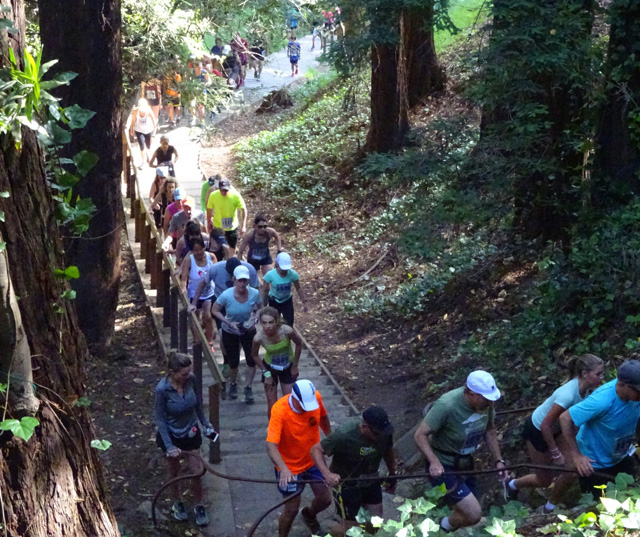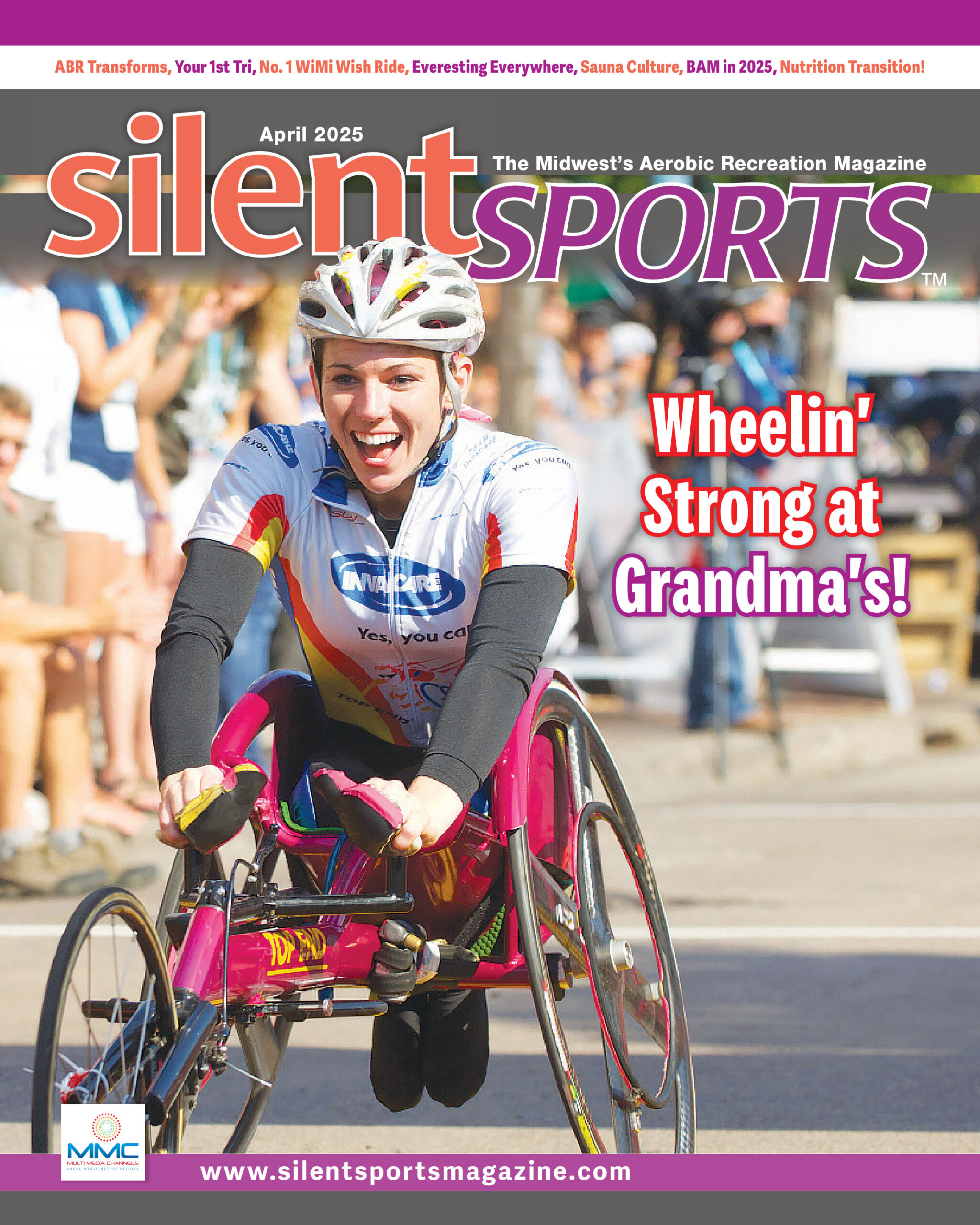Dipsea Running Race

RUNNING
BY EVE GRAVES
An item on my bucket list consisted of running the Dipsea Race (DSR) this past June. First held in 1905 and the oldest trail race in the country, the DSR is billed as one of the toughest and hardest races to get into the first time. Only the Boston Marathon is older.
The DSR is 7.5 miles long and begins in Mill Valley, California, and finishes in Stinson Beach. It features almost 2,200 feet of elevation gain and loss over the course.
Getting in
Becoming a participant in the DSR can be quite challenging the first time. Of the 1,500 participants, 750 people are “invited” runners and the rest are just “runners.” Five hundred of those are on a first-come, first served basis – 300 drawn from the mail, and the rest of us can write “sob stories” and hope it’s convincing enough, or 100 people pay huge sums of money and hope to get in.
Earning the title of “invited” runner involves being one of the first 750 to cross the finish line the previous year.
After perusing the website for months in anticipation of downloading and sending in our registration forms the second it was posted, it finally happened. The back of my husband’s form had a “sob story” in all capital letters – something about how his wife had this on her bucket list and would be mad for a whole year if she didn’t get in!
My “sob story” was more of a challenge to them. Living in Duluth, we are blessed with some of the most challenging terrains in the Midwest. I found it tough to believe that their event could really be more challenging, so I asked them to let me in to prove it.
Getting more information from the DSR is as challenging as getting in. From my experience, emails were rarely returned.
Somehow though, I stumbled upon a phone number, called it and reached Merv, who was in Hawaii but on the board of the DSR. He was very willing to share information with me.
As a last-minute touch, the letters forming the words, “let us run” were affixed to the outside of the envelope.
We were kept in suspense until late April with regards to making housing and airfare reservations for early June!
Getting there
Anticipation finally subsided as we discovered we were both in … on our first try! We had to find housing, set up the car rental and airfare.
We chose to stay in a small vacation rental in Mill Valley. After learning that flying into San Francisco is more time consuming due to the monstrous size of the airport, I would suggest paying the extra and going into Oakland.
Time used departing from the airplane to the rental house was about 3 hours and that was mid-day!
Registration
We flew in on Thursday and picked up our packets Saturday morning for the Sunday event. While attempting to figure out exactly where the race began, we were told numerous times, “be happy you got in, most people don’t.” We found this to be odd since we just wanted to know where the heck to go!
We finally insisted that someone draw us a map and we drove there successfully. We wanted to park as close as possible and then make sure we were at least walking in the right direction!
Race morning
Wanting to ensure close parking and enough “biffy” time pre-race, we arrived almost two hours before our start time.
One of the things that attracted me to this event was the equalizer times. Beginning at 8:30, “invited” runners take off every minute until 8:56. Starting at 8:57 until 9:30, the “other runners” get a chance to start. Each group begins with the oldest and youngest runners. For instance, the 6-year-old girls and the 80-year-old women would start first. The 20-year-old men would go last, or something to that effect.
Being a 51-year-old woman, I started with some 10-year-old girls and some 75-year-old men at 9:09, while my husband, also 51, started at 9:16.
Watching the waves take off every minute after the whistle blew was a neat experience allowing us to see the vast differences in age and ability that would be traversing this most challenging course.
The course
Should we take the treacherous, poison-oak-covered “shortcuts” or the main trail … that was the question. Our plan was to stick to the main trail because the thought of scratching on the confining seats of the airplane the next day was unappealing.
At 9:09, the whistle indicating I could leave the corral to begin my journey along the DSR course sounded. The group of 50-something women along with a few kids and men 20 years my senior, jogged up the slightly inclined pavement to the start of the 700 steps!
My expectation, based on the threatening description of the ominous steps, was quite different from what I actually encountered. The description makes it sound like the steps are made up of narrow and dangerous crumbling rock, broken boards and other instabilities, when in fact they are wide concrete steps with a railing on the side!
My “training” consisted of weekly treks on the Superior Hiking Trail section that contains archaic wood shoved into the side of the very steep Spirit Mountain. It’s made up of about 150 steps without a railing that makes my glutes scream “stop” every so often. The DSR steps were a piece of cake compared to my training route! I even easily passed people while being passed by the “fasties” who started later.
After climbing the DSR steps, the route enters a long downhill on a paved road. My typical lazy running speed hovers around 12 to 14 minutes per mile, so my 7-minute pace down this long decline after using climbing muscles only was detrimental to my quads.
From the downhill, we began our 2.5-mile-trail climb up what they call “Cardiac.” Compared to the gnarly, technically-steep trails that we run on in Duluth, Cardiac is a gentle uphill on a meticulously-groomed trail with a few steeper sections thrown in it. It would have been pretty easy to run, and we did run sections of it, but with the uncertainty of what was to come, we “toured” it instead.
The rest of the course was a mixture of easy up and downhills – except for one point where we accidentally ended up on a “shortcut.” All the previous alternate routes had people at them to let us know of our choice, but this one didn’t.
Being a skilled downhill technical runner, I found the narrow, steep, rough shortcut quite fun except for the thought of poison oak brushing against me throughout. Had I known how easy the shortcuts were to navigate, I would have forgone the regular route and chanced the potential rashes.
We kept waiting for the spectacular views and were fortunate to have one great one towards the end when we departed the woods for our final time. We ran through a field of brown weeds while able to see the ocean and a beach. From there we dipped down onto a paved road and wound around to the finish line.
Typically I am ready to finish all events quite a bit earlier than the finish line. Thanks to the awesome Duluth trail training, the power lines, the Superior Hiking Trail and more, the DSR was significantly less of a challenge than it is described to be. I finished with a fartlek and so much energy that we thought about hiking back to our car at the start line!
After the race
We were informed that if we wanted to wash the poison oak off with Technu, we needed to find a way to transport a gallon of water to the finish line because they were not providing any for us. The one bottle we got as our “refreshments” for the $90 entry fee was for drinking only.
We were given a medal and then told they had “run out” of finisher shirts. Apparently, it wasn’t the first time it’s happened.
There were two small shuttles that took turns making the 30-minute trek back to our cars and back. We enjoyed talking to all the other finishers as we waited 90 minutes in line with poison-oak-covered clothing and shoes.
As we compared medals on the bus, we quickly discovered ours were missing the official engraving on the back that indicated we “survived the 106th Dip Sea.”
Once back at our rental, we quickly stripped and threw all of our clothing directly into the washer, put our shoes and waist packs into a gigantic plastic bag and sealed it. We then showered with Technu in the hopes of preventing the drastic itching.
Overall experience
Would we do it again? Definitely not unless we lived there. Is it worth doing? If you live in an area like Duluth, not really in my opinion – our scenery and challenging trails are far superior. If you live elsewhere or want to be a part of the elite society who has participated in this historical race, then yes, do it!
Meeting new people, seeing the young folk start with the more “mature,” spending time in the woods on a new trail with my husband, meeting the race director Etta and the small equalizer starting waves were all positives during our experience.
Lack of communication, running out of t-shirts, giving us the incorrect medal, a mere bottle of water at the finish, the long wait for the two mini-shuttles at the finish, the cost and travel time are what will prevent us from attempting to get into this event again.

